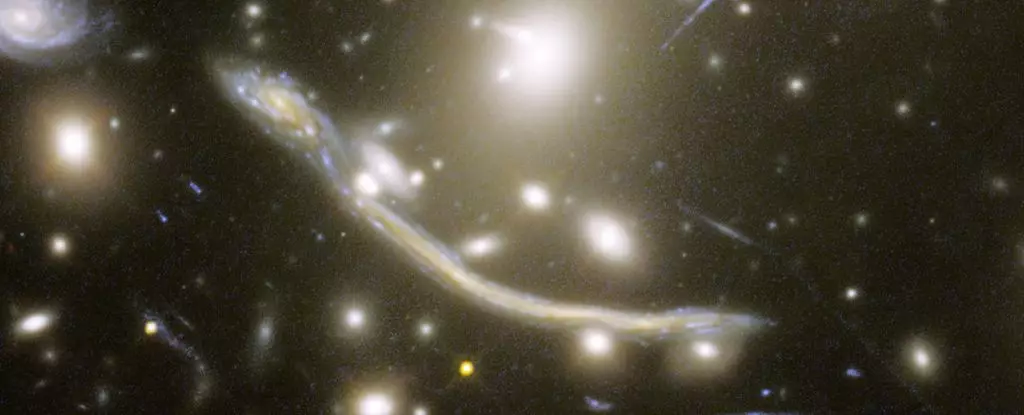The vastness of the universe poses immense challenges for astronomers striving to uncover its secrets. Light from the distant past takes billions of years to reach us, creating an intricate tapestry of cosmic history that is both inspiring and perplexing. The recent advancements brought about by the James Webb Space Telescope (JWST) have offered invaluable opportunities to expand our observational reach, allowing us to glimpse individual stars in galaxies nestled billions of light-years away.
For centuries, the quest to study distant celestial bodies has been limited by the tools available to researchers. Traditional telescopes, such as the Hubble Space Telescope, have captured extraordinary images of galaxies, yet these instruments have struggled to resolve individual stars beyond our local group. The JWST, with its sophisticated technology and capabilities, marks a significant leap forward. It has, for the first time, enabled the resolution of over 40 individual stars in a single distant galaxy, a feat that transforms our understanding of stellar populations on cosmic scales.
Astrophysicist Fengwu Sun from the University of Arizona highlights the significance of these findings, indicating that insights gleaned from studying large numbers of stars retrieved from far-flung galaxies can potentiate our understanding of dark matter. By analyzing how gravitational lensing amplifies and distorts light from these stars, scientists can draw critical conclusions regarding the nature and distribution of dark matter within galaxy clusters. This pioneering research underscores that resolving individual stars is not merely an academic exercise but a vital gateway to fundamental insights about the universe’s structure.
One of the revolutionary methods facilitating these discoveries is gravitational lensing, a phenomenon rooted in Einstein’s theory of general relativity. When massive celestial bodies exert significant gravitational force, they warp the space-time fabric surrounding them, similar to how a bowling ball distorts the surface of a trampoline. This bending of light allows astronomers to witness light from distant galaxies as it arcs around these immense structures.
The Dragon Arc, a striking projection of light resembling its namesake, exemplifies the power of gravitational lensing. Attributable to the gravitational influence of the Abell 370 galaxy cluster, located approximately 4 billion light-years from Earth, the Dragon Arc serves as an extraordinary natural lens, creating multiple images of the same distant galaxy. While the cluster’s gravity creates an intricate mosaic of distorted light, astronomers can deconstruct this effect to unveil a clearer view of the galaxies beyond, allowing for new discoveries that were previously thought impossible.
Beyond the macro lensing effects of galaxy clusters, astronomers also leverage a subtler phenomenon known as microlensing, which comes into play as individual stars within the clusters act as additional lenses. Each star can produce its lensing effect, allowing researchers to identify solitary star points amid the chaotic light. A team led by Yoshinobu Fudamoto from Chiba University made significant breakthroughs in using microlensing to observe individual stars in the context of the Dragon Arc.
This innovative approach led to the remarkable resolution of 44 individual stars, providing insights into stellar populations that are not typically observable over such vast distances. Fudamoto’s group, initially in pursuit of a distant galaxy, serendipitously stumbled upon these individual stellar points, highlighting the unpredictable nature of astronomical exploration.
The stars identified in the Dragon Arc primarily consist of red supergiants, immense stars in the twilight of their lifecycle. These cooler stars, with their distinctive hues, contrast sharply with the clearer, brighter blue and white giants that dominate previous observations. The JWST excels in detecting this red light, revealing an entirely new aspect of stellar evolution beyond what was previously known. This finding exemplifies how technological advancements can reshape our comprehension of the cosmos.
The study of red supergiants not only embellishes our understanding of stellar lifecycles but also informs us about the environments in which these stars evolve. Each discovery derived from JWST observations expands our knowledge about the history and developmental processes of galaxies that loomed in the distant past.
As the JWST continues its mission, astronomers remain poised to unveil even more about the universe’s treasures. Each observation reveals layers of complexity that propel the field of astronomy into new frontiers. By unmasking hidden stars and collecting data that enhances our understanding of dark matter and stellar evolution, JWST solidifies its position as a harbinger of revolutionary discoveries.
The strides made by the JWST in observing the distant cosmos exemplify not only the triumph of human ingenuity over the limitations of our observational tools but also the insatiable quest for knowledge that continues to propel scientific inquiry. With each new finding, our view of the universe grows richer and more intricate, inspiring future generations to seek answers to the profound questions that the cosmos poses.


Leave a Reply